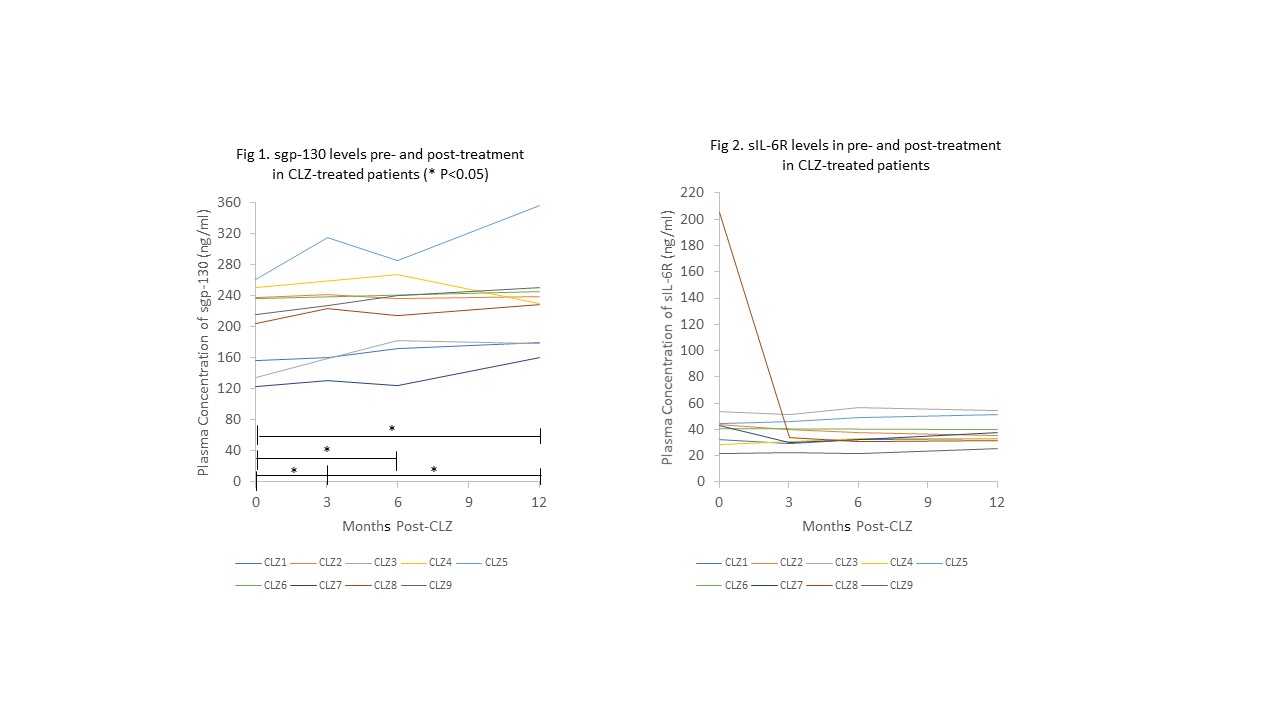Clazakizumab (clz, Anti-il-6 Antibody) Treatment Affects Il-6/il-6r Signaling by Increasing Soluble Gp130 (sgp130) in Hla-sensitized Kidney Transplant Patients (hs Ktx Pts) Treated for Chronic Antibody-mediated Rejection (cabmr)
Cedars-Sinai Medical Center, Cerritos, CA
Meeting: 2021 American Transplant Congress
Abstract number: 1048
Keywords: Alloantibodies, Drug interaction, Kidney, Preclinical trails
Topic: Clinical Science » Kidney » Kidney Chronic Antibody Mediated Rejection
Session Information
Session Name: Kidney Chronic Antibody Mediated Rejection
Session Type: Poster Abstract
Session Date & Time: None. Available on demand.
Location: Virtual
*Purpose: IL-6 is a pro-inflammatory cytokine responsible for chronic vascular inflammation and a promising target for cABMR modulation. IL-6/sIL-6R complex initiates more pathogenic trans-signaling pathways via interactions with gp130 expressed on various tissues including allografts, and sgp130 is a selective inhibitor of this pathway. We previously reported the increase of plasma sgp130 level at 6 month post-treatment in HS KTx Pts treated with CLZ, and suggested its beneficial effect on cABMR modulation. Here, we report on sIL-6R and sgp130 levels further monitored until 12 months post-treatment in these CLZ-treated Pts and correlated with other clinical findings.
*Methods: Plasma samples obtained pre- and post-CLZ (25mg SQ, monthly) (up to 12 months) from 9 HS KTx- Pts with biopsy proven cABMR were submitted for sgp130 and sIL-6R Luminex assays. IL-6, C-reactive protein (CRP) and DSA levels were also measured.
*Results: IL-6 levels significantly increased post- vs. pre-CLZ (1113±300 vs. 17±19pg/ml, p=0.005). Near significant reduction of CRP post-CLZ (1.7±1.5 vs. 0.4±0.1µg/ml, p=0.05) in all Pts indicates that high levels of IL-6 detected post-CLZ were mostly CLZ-bound IL-6, and the IL-6/gp130 signaling was efficiently blocked by CLZ. Sgp130 levels gradually increased post-CLZ (Fig. 1), and reached the levels at 12 months post-CLZ, significantly higher than pre-CLZ levels (230±55 vs. 203±49ng/ml, p=0.03). In contrast, sIL-6R levels did not change post-CLZ (Fig. 2). Reduction of DSA and stable eGFR at 24 months post-CLZ were observed although no significant improvement of Banff score for cABMR was observed yet at 6M post-CLZ.
*Conclusions: CLZ affected IL-6/IL-6R/sgp130 biology that may result in a risk for progression of cABMR. Significant increases of sgp130 post-CLZ may reduce trans-signaling, potentially reducing pathogenicity to allografts, which may contribute in part to stabilized eGFR in this patient population. A larger randomized control study is required for confirming this possibility.
To cite this abstract in AMA style:
Shin B, Ge S, Jimenez A, Ammerman N, Vo A, Zhang R, Jordan SC, Toyoda M. Clazakizumab (clz, Anti-il-6 Antibody) Treatment Affects Il-6/il-6r Signaling by Increasing Soluble Gp130 (sgp130) in Hla-sensitized Kidney Transplant Patients (hs Ktx Pts) Treated for Chronic Antibody-mediated Rejection (cabmr) [abstract]. Am J Transplant. 2021; 21 (suppl 3). https://atcmeetingabstracts.com/abstract/clazakizumab-clz-anti-il-6-antibody-treatment-affects-il-6-il-6r-signaling-by-increasing-soluble-gp130-sgp130-in-hla-sensitized-kidney-transplant-patients-hs-ktx-pts-treated-for-chronic-antibod/. Accessed December 18, 2025.« Back to 2021 American Transplant Congress

